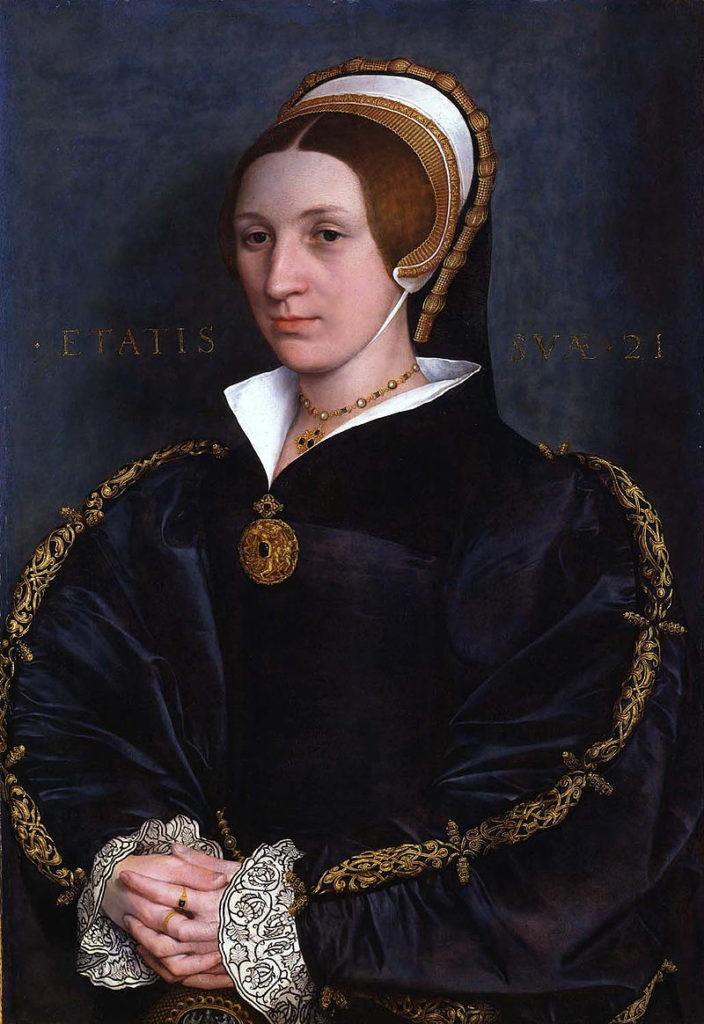
In March 1537, Jane Seymour’s sister Elizabeth, a widow in a somewhat impoverished state, had written to Thomas Cromwell hoping to be considered for an award of lands from one of the dissolved abbeys. Instead, Cromwell took advantage of the opportunity to propose that she marry his only son and heir, Gregory. For Cromwell, this would be a huge step – he would be related to the King (not directly, more like an uncle-in-law, but the guys was a blacksmith’s son for goodness’ sake!). With Elizabeth’s consent, he worked out the terms with his good friend Edward Seymour and by June everything had been agreed.
Cromwell set his soon-to-be daughter-in-law up at Leeds Castle in Kent pending the wedding. She wrote him the following letter from there, making it clear that she had been well-educated (which is interesting to note since the lack of letters from Jane Seymour suggested to some historians that she might have been illiterate – this would argue against that conclusion). Without further ado, a charming missive from a bride-to-be to her powerful new father-in-law:
To the right honorable and my singular good lord, the Lord Privy Seal:
In most humble wise, as your assured poor beadwoman, I cannot render unto your lordship the manifold thanks that I have cause, not only for your great pain taken to devise for my surety and health but also for your liberal token to me, sent by your servant master Worsley; and farther, which doth comfort me most in the world that I find your lordship is contented with me, and that you will be my good lord and father: the which, I trust, never to deserve other but rather to give cause for the continuance of the same. Pleaseth it your lordship, because I would make unto you some direct answer, I have bene so bold to be thus long ere I have written unto you. And where it hath pleased your lordship as well to put me in choice of your own house as others, I most humbly thank you; and to eschew all sayings, I am very loth to change the place where I now am, and where my brother my lord’s house shall remove, the which, if such need e, shall be at one Ambrose Wellose, a quarter of a mile from your lordship’s place, as master Worsely can inform your lordship more plainly thereof. And where it hath pleased your lordship to give me leave, and also commandeth me, if I want, to send to you, and that I may be bold to open my heart, I ensure your lordship my heart hath been a great time in such trust; and now this letter from you, with that I find in it, doth me more pleasure than any earthly good for my trust is now only in you, and if I have any need I shall obey your lordship’s commandment herein. And thus I shall daily pray unto God for the preservation of your lordship most prosperously in health to continue. Amen.
Prayeth your humble daughter-in-law,
Elizabeth Ughtred
A quick note: we have letters from many great Tudor ladies in which they refer to themselves as “beadwomen,” often at the same time as they refer to themselves as friends and servants. While I cannot find a firm reference, the context suggests that the “beads” refer to the rosary so that they were assuring their recipients that they were praying for them. If anyone has any information about this, I’d love it if you’d share in the comments below!
SOURCES:
***
If you like my posts, you’ll love my books! My Seymour Saga trilogy tells the gripping story of the short-lived dynasty that shaped the Tudor Era. Jane the Quene skews romantic, The Path to Somerset is pure Game of Thrones (without the dragons), and The Boy King is a noir coming-of-age. Get them now through Amazon, Barnes & Noble, Kobo, and Apple, or even your local independent bookstore!

(PS Already read them? Did you love them? Then please review them – even just a stars rating! It makes a huge difference in helping new readers find them and would mean the world to me!)

From the Oxford English Dictionary:
beadsman
/ˈbiːdzmən /
▸ noun
(pl. beadsmen)
historical- a pensioner provided for by a benefactor in return for prayers, especially one living in an almshouse.
Hope this helps!
Love it, thanks!
I though the painting was now thought to be Katherine Howard’s Henry VIII’s fifth wife.
Just the opposite – it was originally thought to be Catherine Howard, then more recently identified as Elizabeth Seymour!
An early spelling was ‘bedesman’, and this may well be a reference to Bede. Elizabeth is probably implying that she would pray for Cromwell’s soul, since he was rescuing her from penury. She had been married at a very young age to the Governor of one of the Channel Isles, and was used to the high life. Now, as a widowed mother of two (one an infant in arms) living in Yorkshire, she was surrounded by the devastation that followed the brutal suppression by Henry VIII of the Pilgrimage of Grace, achieved by means of characteristic treachery by Cromwell himself.